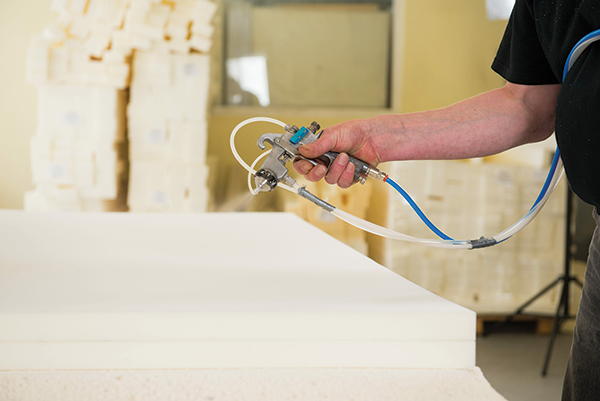Whether measured by weight or volume, glue makes up a tiny percentage of a pocketed spring unit, and there is some disagreement in the mattress industry and recycling sector about how much adhesives contribute to challenges of recycling the units.

Depending on the dismantling method, the adhesives can make it harder to break the units into their key components of steel and fabric, and the glues can potentially contaminate the fabric encasement (typically a polypropylene) or other materials in the mattress, such as foams. And that lowers their value in commodities markets.
“In recent years, advances in machinery for pocketed coil recycling are allowing for easier separation of the metal coils from the polypropylene fabric. The challenge, however, is that the adhesive on the fabric, which is typically an EVA (ethylene-vinyl acetate) adhesive, must be extracted from the textile, which requires an additional processing step. Worse yet, for recyclers that don’t have the capability to implement this extraction process, the fabric is considered contaminated with adhesive and thus limits its uses or it becomes waste,” says Jim Turner, CEO of adhesives producer SABA North America LLC, which has headquarters in Kimball, Michigan. Parent company SABA Dinxperlo BV is based in Dinxperlo, Netherlands.
Many adhesive suppliers, including SABA, are addressing those and related issues with creative solutions.
For example, SABA is developing a propylene-based hot melt that “will allow for 100% recycling of the polypropylene fabric without an (adhesive) extraction step,” Turner says. Another benefit, according to Turner: The adhesive will work with existing pocketed coil production machinery that uses glue for assembly, meaning manufacturers don’t have to install new equipment to use the propylene-based adhesive.
In our opinion, a profound partnership among us, mattress producers and machine manufacturers is the key to achieve measurable, sustainable results without compromising the mattress performance during the mattress life cycle.
SABA’s second initiative looks at adhesives and recycling in a whole other way: “We are working on a process that will allow us to use recycled pocketed coil fabric and integrate this material back into our existing hot-melt adhesive formulations used for mattress assembly,” Turner explains. “The initiative will support the mattress recycling industry by creating a new use for spun-bond polypropylene once separated from the metal coil units. … In this way, every pound of hot melt that we produce and sell will include a small part of a recycled mattress and, thus, support circularity within the industry.”
SABA expects to unveil the adhesive and introduce its new proprietary process in the first quarter of this year.
As part of its overall sustainability efforts, Henkel offers two adhesives for pocketed spring assembly — Technomelt AS 8275 Coil and Technomelt Supra 126. Both reduce glue and energy use, among other benefits.
But “imagine having a solution that enables a shorter disassembly (debonding) time, increases recycling efficiency and reduces labor,” says Camille Adams, head of market strategy, furniture and building components for North America for Henkel, which has U.S. headquarters in Bridgewater, New Jersey, and global headquarters in Dusseldorf, Germany. That’s what the company’s Technomelt Pur 7117 offers. It’s a polyurethane hot melt that, Adams says, “promotes mono material recycling, working as a polyurethane adhesive for urethane foam,” leaving uncontaminated foam ready for recycling.
Savaré Specialty Adhesives LLC, based in Delaware, Ohio, is also addressing the matter of contamination, offering a polypropylene-based adhesive “compatible with the spun-bond (nonwoven) used for pocketed coils, which enables full recyclability” of the fabric, says Paolo Campitelli, Savaré assembly industry manager for North America. Campitelli’s division is part of Savaré Srl based in Milan.
“The product — formulated and introduced to the European market in 2022 — was very well received by our customers,” Campitelli says. “The additional cost, compared to traditional formulations, makes it, for the time being, a candidate for specific mattresses and brands.”
Innovations like these illustrate the variety of ways suppliers are taking the issue of mattress recycling seriously and designing products with sustainability in mind.
“Savaré R&D is constantly working on innovative projects that would help recyclers dismantle mattresses in a more efficient process,” Campitelli says. “In our opinion, a profound partnership among us, mattress producers and machine manufacturers is the key to achieve measurable, sustainable results without compromising the mattress performance during the mattress life cycle.”




